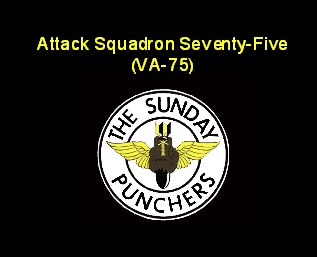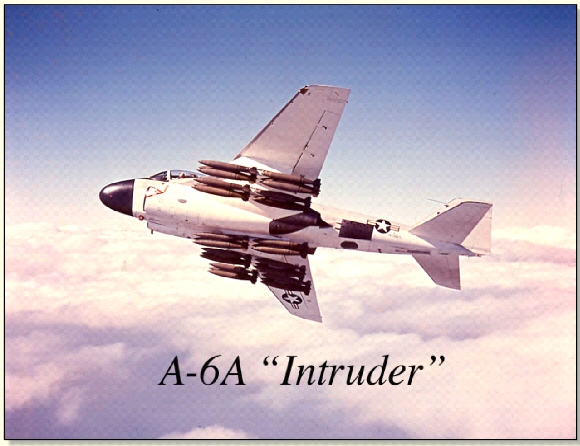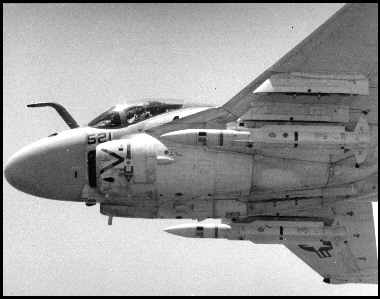|
Bad weather and night flying. On bad weather days and during night operations we flew single plane A-6 strikes and did low level system bombing on radar. Normally there were two aircraft carriers on Yankee Station at all times and each carrier would fly for a 12-hour period. One carrier would fly from 10 AM to 10 PM and the other carrier would fly from 10 PM to 10 AM the next day. We much preferred the latter schedule because there was more night-time, and we liked to fly at night. Why did we like to fly at night…..well….
• The A-6 was designed to fly at night and in bad weather.
• You could see SAM missiles lift off a long distance away.
• Enemy gunners couldn’t see you to shoot at.
• We never had a problem with enemy MIG aircraft because they would never come out at night or down to our altitude, because we flew pretty low.
We generally flew one or two missions a day per aircrew and we had 19 to 20 aircrews in the squadron. Our normal cycle was 20 days on Yankee Station and then 7 days off for R&R in the Philippines. However, at the end of our first 20-day line period our relief, the USS Enterprise, wasn’t there. The Navy spy ship USS Pueblo (AGER-2) had been captured by the North Koreans in international waters and the Enterprise was up North in Korean waters. As a result, Kitty Hawk flew 61 continuous days of combat strikes without a break, a Navy record for the Vietnam conflict. The Hawk was awarded the Presidential Unit Citation for doing so.
Operation Rolling Thunder
Operation Rolling Thunder was the name of air war against North Vietnam. This air war was different than any prior conflict. Why was it different: surface-to-air missiles. This was the first conflict in which U. S. aviation forces encountered guided missiles or SAMs. SAMs changed the nature of the air war. It forced our aircraft down from higher to lower altitudes where we had better turn performance against the missiles. But by coming down to lower altitude it made us much more susceptible to anti-aircraft (AAA) fire and small arms fire. It was AAA and small arms that shot down the majority of the U. S. aircraft
Operation Rolling Thunder started on 24 February 1965 (long before we arrived on Yankee Station) and ended on 31 October 1968, about four months after we departed Yankee Station. It was characterized by not being a full scale bombing campaign but a gradual escalation. Even when we started flying combat strikes in December 1967, many of our targets were of little worth or significance (i.e. suspected truck parks, ferry crossings, cave storage, road intersections, small bridges, etc.) However, during our deployment the target selection improved substantially (i.e. power plants, small industrial plants, rail yards, airfields, radio communication sites, port facilities, etc.) We could not select our own targets. We could only bomb targets on the list approved by the Pentagon and/or the White House.
Operation Rolling Thunder was not as effective as it could have been and here are some reasons why:
• Bombing Pauses. Just when we were finally getting some real good night bombing targets, on March 31, 1968, Washington decreed that there would be no bombing above 20 degrees North latitude. Well, all the good targets were above 20 degrees North latitude. Of course, North Vietnam used the bombing pauses to repair and resupply their air defenses.
• Self Imposed Restrictions. Many large targets were not on the approved bombing list and many targets that were on the list were not very good targets.
• Self Designated Sanctuaries. There was no attacking the dams on the Red River or the port facilities of Haiphong. We could have destroyed the dams and flooded the entire Red River Valley, but Washington put them off-limits.
Sixty percent of the supplies coming into North Vietnam came through the port city of Haiphong. We could not touch the port facilities. They would let us bomb small bridges leading out of the city, but not the main harbor wharfs and shipyards. One reason may have been that the Russians kept one of their ships anchored in the main channel of Haiphong at all times and Washington might have been afraid that we would hit it (We actually did damage the Russian ship one day and they had to tow it back to Russia. But, even when it was gone, they would still not let us touch the harbor facilities). I will cover the Russian ship incident a little later.
• No Mining of Major Harbors. There was no mining of major harbors until 8 May 1972, shortly before the end of hostilities. We should have mined every harbor in North Vietnam from day one of that conflict.
• No Strategic Targets. There were no strategic targets on our bombing list and that is no way to fight a war if you want to win it. Apparently Washington didn’t want us to.
I don’t mean to imply that Rolling Thunder was ineffective. It was effective in many ways, but not as effective as it could have been. When you consider that North Vietnam absorbed 653,000 tons of bombs and had 90,000 casualties and $164 million in damage, that's a pretty large cost for such a small country. However, the cost of the U. S. losing 58,286 KIA and 2,730 aircraft (just USAF, Navy, USMC) our cost was substantially greater.
Fortunately Washington came to their senses and in February 1972, most of the above restrictions were lifted. The U. S. commenced Operation Linebacker I followed by Linebacker II, the unrestricted bombing of North Vietnam. Major harbors were mined and our air forces did sustained bombing of most cities. The B-52s were included and did carpet-bombing of parts of Hanoi. North Vietnam fired so many missiles at our aircraft they ran out of SAMs and the heavy bombing finally brought North Vietnam to the peace table.
If there is one lesson to be learned from combat in Vietnam, it is don’t micromanage the war. Give the military a mission, their rules of engagement and other constraints, and let them do the job the way they know best. That’s what was done in Desert Storm/Desert Shield.
When Washington imposed the no flying above 20 degrees North latitude rule, most of our good targets were not available. We then utilized one of the better capabilities of the A-6 – AMTI (Airborne Moving Target Indicator). We did lots of AMTI work in the southern part of North Vietnam, which we called “Happy Valley”. Below is a rather poor picture of the radar scope in the A-6. The Radar display was rather primitive when compared to a FLIR display which VA-75 later received in the A-6E (FLIR and laser designator) after our combat deployment.
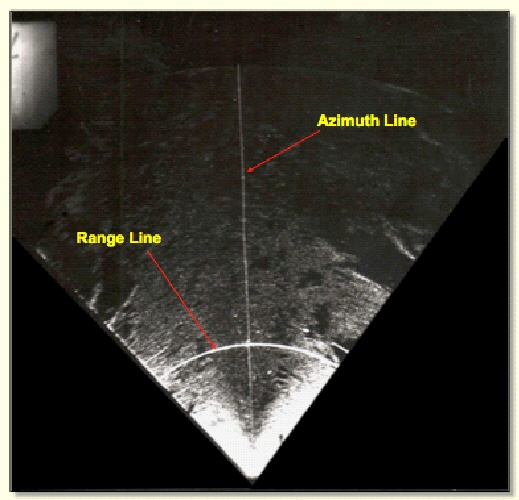
Radar Display in the A-6A
In the A-6A, when you turn the AMTI switch ON, the radar cancels all radar returns EXCEPT from moving targets. The picture below is the radar with the AMTI Mode ON.
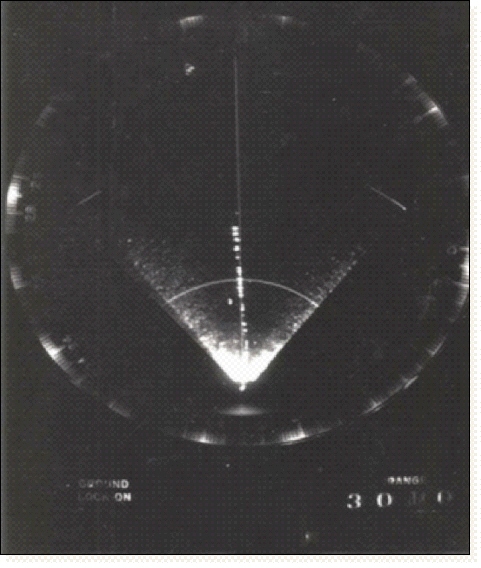
AMTI Mode ON
Looks like a busy highway with lots of vehicle traffic. The pilot would turn the aircraft to line-up on the column of vehicles, turn his track radar on to lock on one of the vehicles and then drop a string of bombs or other ordnance. This was a very effective mission or the A-6.
The Mark-36 Destructor. Since we could not mine the main channel in Haiphong, there were lots of other waterways that we could mine and impede the flow of traffic. The Navy developed the Destructor series of weapons. The Mk 36, 40 and 41 were respectively conversions of MK 82 500lb, Mk 83 1,000lb and the Mk84 2,000lb bombs. Just remove the contact fuse in the nose of the bomb and install the Mk 75 mod kit with a battery pack in the tail. These bombs are now aerial magnetic mines for use on land or water as an area denial weapon. We used these weapons around ferry crossings, road intersections and major transportation arteries to make life difficult for the Vietnamese. One thing about the Destructor, you are never around when they go off, so you don't have any indication of whether they really work. Well, we have two rather unfortunate verifications they really worked quite well.
(1) Incident #1. One day we had some A-4 or A-6 aircraft returning to the Kitty Hawk with hung or unused MK-36 Destructors. The ship vectored the aircraft to an area in the Gulf of Tonkin and told them to drop their ordnance. I think the ship personnel did not quite know what they doing, but the aircraft complied and dropped their weapons. About 3-4 weeks later the Kitty Hawk ran over the Destructors and when they went off I thought one of the ships main magazines blew. It really shook the ship! Fortunately they were 500lb Destructors and the depth of water in the gulf was a little too deep to punch a hole in the hull of the Hawk. But Incident #1 proved that the destructors worked as advertised.
(2) Incident #2. On 4 January 1968, a mission was ordered to seed a cannel right in the middle of Haiphong with MK 36 Destructors. The canal was perpendicular to the main harbor channel. (See the photo below. The canal with the red line is the canal to be seeded). The red line indicates where the lead aircraft's Destructor string of mines was to land. Succeeding aircrafts strings would be further down the canal.
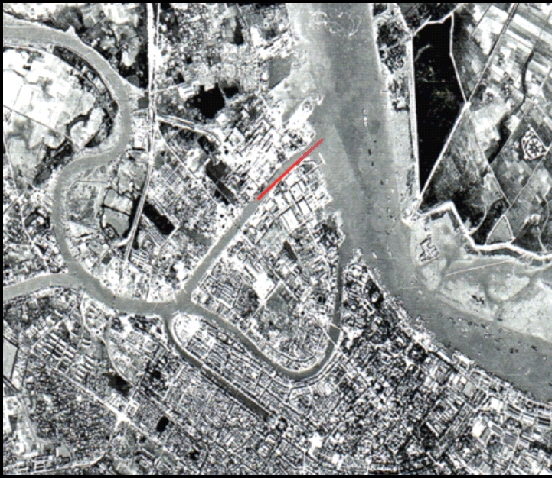
Haiphong Harbor Showing the Seed Canal and Main Red River Channel
The day before the seeding mission my XO took the aircrews to mission planning to plan a rather difficult mission. We didn't have very good charts of Haiphong harbor at the time so the flight planning was done using a French chart. Each flight crew laid out from his aim-point a 1,500 foot length bomb string. Four of the 1,500 bomb strings would cover the entire canal. The Destructors were to be dropped visually in a 45 degree dive. With mission planning completed the XO briefed the members of his flight and they launched at 1430 on January 6th. A few hours after the A-6As returned to Kitty Hawk, reports started coming in from Russia about "a day that will live in infamy." They said that the U. S. Navy had bombed their ship below. Read the following message to ALCON below the ships photo.
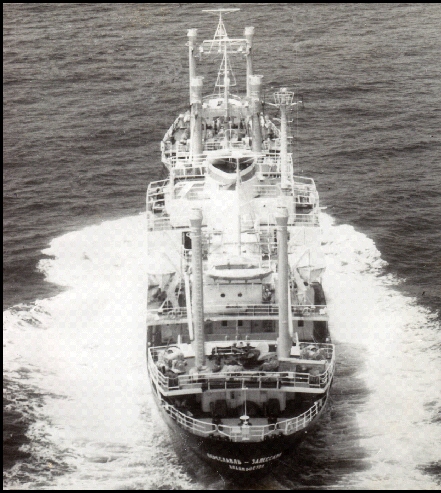
Russian Ship Peresalvl Zalesskiy
FM FBIS OKINAWA
TO RU
CINCPACAF MACT J-2
CINCPACFLT USIS BANGKOJ THAILAND
CINCPAC HAWAII CINCUSARPAC HAWAII
COMUSMACV COMUSKOREA
COMSEVENTHFLT 5TH AF FUCHU AIRSTA JAPAN
CTF SEVENTY SEVEN
UNCLAS
HANOI VNA INTERNATIONAL SERVICE IN ENGLISH 0539 GMT 6 JAN
(MORE ON US BOMBING OF SOVIET CARGO IN HAIPHONG PORT)
(TEXT) HANOI, 6 SIX JANUARY-DURING THEIR RAIDS ON HAIPHONG PORT CITY ON FOUR JANUARY, BESIDES DROPPING THEIR EXPLOSIVE DELAYED ACTION AND STEEL PELLET BOMBS ON THE HARBOR ITSELF, DAMAGING THE SOVIET CARGO SHIP PERESALVL ZALESSKIY WHICH WAS UNLOADING AT THE PORT.
IMMEDIATELY AFTER THE RAID, LOCAL AUTHORITIES SENT REPRESENTATIVES TO INQUIRE ABOUT THE CREW'S CONDITION AND THE DAMAGE CAUSED TO THE SHIP. THE SHIPS CAPTAIN BORIS TSEVSKOV (RUSSIAN NAMES AS RECEIVED) AND POLITICAL COMMISAUR SEMEN MASTOV RELATED THE RAID ON THE SHIP AS FOLLOWS:
AT 1540 HOURS, FIFTEEN U.S. PLANES COMING FROM THE NORTHWEST FLEW PAST THE SHIP PERESALVL ZALESSKIY AND DROPPED MANY DELAYED ACTION BOMBS AROUND THE SHIP. AT 1550 HOURS A BOMB EXPLODED ABOUT 100 METERS FROM THE STERN, SENDING UP A HIGH COLUMN OF WATER. THE SHIP WAS VIOLENTLY SHAKEN. FIVE 5 MINUTES LATER ANOTHER BOMB EXPLODED ABOUT 2 TWO METERS FROM THE PORT SIDE. THIS EXPLOSION CAUSED SOME DEFORMATION TO THE HULL. MANY WINDOWPANES AND CEILING LAMPS IN THE SAIL CABINS WERE BROKEN. THE BEDAKPLATE OF THE MAIN ENGINE WAS HITCHED UP, THE AUXILIARY ENGINES AND CRANE OPERATING GENERATORS WERE WRECKED AND THE SHIP COULD NOT MOVE ON ITS OWN.
UNTIL 2040 HOURS BOMBS CONTINUED TO EXPLODE SPORADICALLY AT DISTANCES OF 30-60 METERS FROM THE SHIP. AT 1720 HOURS A BOMB WENT OFF ABOUT 15 METERS FROM THE STERN AND AT 1920 HOURS AGAIN A BOMB EXPLODED ABOUT 60 METERS FROM THE PORT BOW. PRESENTLY MANY TIME BOMBS REMAIN UNEXPLODED AROUND THE SHIP. CHIEF ENGINEER VALENTIN SHAPOVALOV VADE KNOWN THAT THE WATER AND FUEL CONDUCTS OF THE SHIP HAD BEEN PUT OUT OF USE. THE FUEL PUMP MOTOR AND THE RUDDER SYSTEM HAD ALSO BEEN SERIOUSLY DAMAGED AND THE RADAR INSTALLATION WAS PUT OUT OF ORDER.
Admiral Cousins, (CTF-77) asked us to investigate why we hit the Russian ship. My XO and several of the Flag Staff went over the procedures used in planning the mission and they finally found the problem. The scale used on the French chart was wrong. Accordingly, the measured 1,500 foot stick length from the first aircraft was actually 3,000 feet long and the Destructors went right over the Russian ship anchored in the main channel. Every time the tide changed and the ship swung at anchor, one of the 500lb Destructors would go off. This continued for about six hours. The explosions blew the ships main engines right off their mountings and the ship had to be towed back to Russia for repairs. Additionally, one of the Destructor strings went right though Haiphong shipyard #4. They could not use the shipyard or the canal until the Destructors were detonated or removed. The Admiral was overjoyed. Here is a second example of the Destructors working as advertised.
Bombing Mission to Downtown Hanoi
In February 1968, I had the pleasure for flying two bombing missions to the Hanoi area. On February 10th my B/N LCDR Mike Hall and I bombed the Hanoi Radio Communications Station southeast of Hanoi. On February 24th we bombed the Hanoi Port Facilities in downtown Hanoi. Both of these missions were interesting, but the Hanoi port facilities strike had some very interesting twists, which I will cover.
On February 22nd, the USS Enterprise returned to Yankee Station from Korean waters and Kitty Hawk departed for some long overdue R&R in the Philippines. On February 23rd we were within sight of the Philippines and everyone was getting ready to go on liberty, when a message came in from CTF-77. The message ordered a four plane A-6 aircraft strike on the Hanoi Port Facilities right in downtown Hanoi. Because the Enterprise had only been on Yankee station for one day, CTF-77 ordered a joint Enterprise/Kitty Hawk A-6 strike. I quickly assembled my flight crews in our ready room, informed them of the mission to Hanoi and asked "who wants to go with me"? My Safety Officer, LCDR Jerry Fink and his B/N LT Fred Hewitt said they would go. The Kitty Hawk launched two of our aircraft for Enterprise and we landed aboard that afternoon and did mission planning for the strike with flight crews from VA-35, the Enterprise A-6 squadron.
During flight planning we reviewed the SAM and AAA order of battle. Hanoi was the most heavily defended city in the history of warfare with 21 active SAM sites and thousands of gun barrels of AAA. Here is what the AAA picture looked like.
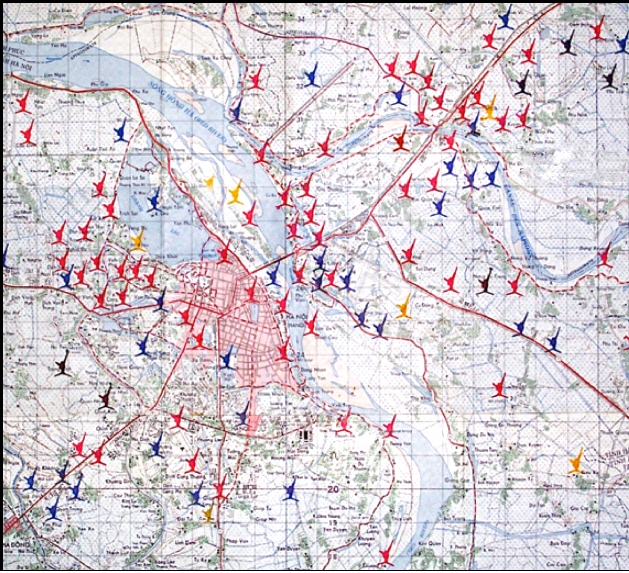
Hanoi AAA Order of Battle, February 1968
The gun symbols on the chart above are not individual gun barrels, they are AAA sites with five to seven gun barrels at each location. Brown colored gun symbols are 105mm, blue are 85mm, red are 57/37mm and yellow are automatic weapons. Only in placing the yellow, we ran out of yellow ink. Automatic weapons were all over the place
An aerial photo of the Hanoi port facilities is shown in the picture below. Two aircraft from VA-35 were to bomb the southern half of the complex and retire straight up the Red River until North of the city and then head west into the mountains. The two aircraft from VA-75 were to bomb the northern section of the port facilities complex, turn hard left and fly right over the center of Hanoi at 400 feet and head for the mountains.
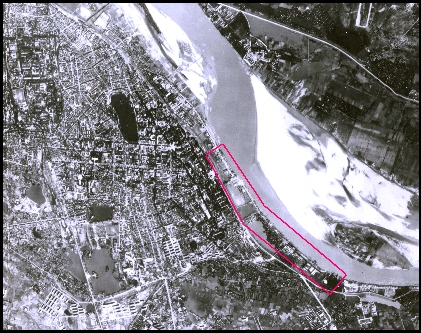
Hanoi Port Facilities (outlined in red) with the Red River flowing south toward Haiphong
Below is a copy of my actual flight chart for the mission (with annotation)
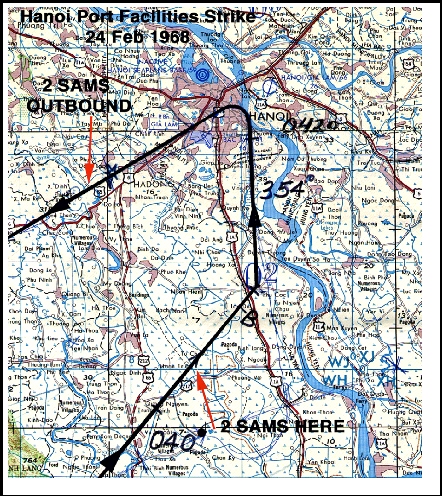
After the mission planning we ate dinner and hit the sack early. Reveille was at 0030. We put on our flight gear and headed for the VA-35 ready room where we re-briefed the mission with VA-35 flight crews. We manned aircraft at 0200 and launched at 0230.
I should explain something about the A-6A before going further. When you launch from the ship and fly night missions it is like flying into an ink well. There are usually zero visual references outside the cockpit, so you have to depend 100% on your flight instruments to tell what the aircraft is doing. In the A-6A the primary attitude reference is the ten-inch wide Visual Display Indicator or (VDI) shown below and located right in the center of the pilots instrument panel.
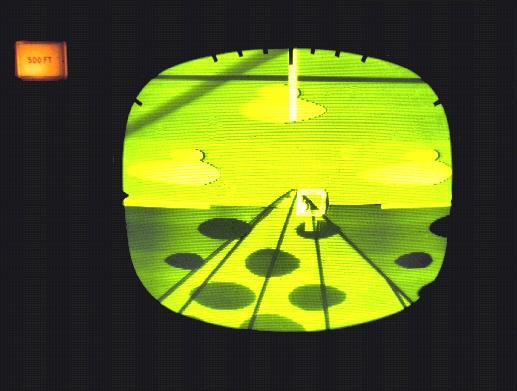
The VDI is a computer-generated display with the light area with clouds (the sky) and the darker area below (the ground). In the ground area, there is a continuous stream of small elliptical dark spots that appear at the horizon, move slowly down the scope and disappear off the bottom. The spots grow slightly in size as they move down the scope. This gives the pilot a sense of motion in the plane perpendicular to the VDI and it completely eliminates vertigo. I occasionally used to get vertigo when flying other type aircraft, but never in the A-6. This is an essential requirement when dodging SAM missiles at night. The triangular shape in the center of the VDI is the "pathway in the sky" and is the means by which the B/N gives steering information to the pilot. If the B/Ns radar azimuth line is on a target or navigation check-point to the left, the pathway on the VDI will point to the left. When the B/N says "take steering" the pilot turns left and the triangle moves back into the center of the VDI. The aircraft is now heading for the next checkpoint or to the target. Nearing the target the B/N will step the computer into attack and the computer starts rapidly calculating bombing solutions. A black horizontal bar will then appear on the right side of the VDI. This is the signal for the pilot to squeeze a trigger on his control stick and keep squeezing. The black bar moves vertically down the scope as you close the target. When it disappears off the bottom of the VDI, the bombs come off automatically. The computer picks the right point in space to release the bombs independent of whether the pilot is climbing, descending, flying level or pulling up and tossing the bombs into the target.
One additional point, the VDI is stabilized by an inertial system (INS) in the aircraft. The INS keeps the horizon of the VDI parallel to the earths surface at all times, even if the aircraft is in a 90 degree bank pulling 6g's.
In VA-75 the B/N always does the alignment of the INS in the aircraft. In VA-35 on the Enterprise, the ground crew could start the alignment of the INS and that was to have some implications for my flight to Hanoi.
When we arrived on deck of the Enterprise for the Hanoi strike, the A-6 INS was already aligning. We continued our pre-flight procedure and the B/N typed the coordinates of the entire navigation route into the computer.
I was the third of four A-6s to launch. As we moved down the catapult track my VDI display turned upside down. This is the first time it ever happened to me. Had I followed the roll of the VDI to the right, I would have hit the water inverted in front of the ship. Fortunately, as we moved down the catapult track my B/N Mike Hall, saw the warning light on the INS system illuminate and yelled "platform, platform". I knew that meant the INS had a problem and I went right to a 2-inch standby gyro on the instrument panel. I raised my landing gear and flaps as the aircraft accelerated and climbed out on the standby gyro. I called the ship and told them that my VDI tumbled on the cat shot and they said "roger."
Why did the VDI tumble? We found that the VA-35 ground crew had aligned the INS in the polar mode. You never, never use the polar mode unless you are in the polar regions (That is above 65 degrees north or south latitude). We were at 18 degrees north latitude. Aligning our INS in the polar mode at 18 degrees latitude created high velocity errors in the INS, and as we moved down the catapult track the INS platform tumbled.
I rendezvoused with the rest of the flight over Enterprise at 12,000 feet to top off our fuel for the long flight to Hanoi. Because of our INS problem I was now the last aircraft to tank. As number three aircraft cleared the tanker, I moved into position to plug-in and receive fuel. Suddenly, the lights on A-3D tanker went out. He had an electrical failure and could not give me any fuel. This is the second event that happened in the first 10 minutes of the flight and I am beginning to think it wasn't going to be my night. My B/N and I discussed the situation and decided to try an in-flight alignment of the INS (which I had never done before). That meant flying straight and level with minimal turns for about 20 minutes. After 22 minutes, we got a ready light on the INS. We then checked our fuel quantity. It was going to be close, but I thought we had enough fuel to complete the mission. We were now 22 minutes behind the rest of the flight, but headed into the mountains southwest of Hanoi. Since we were behind the rest of the flight who stirred up a hornets nest at Hanoi, I thought that when we arrived at our target everyone would be awake and shooting, and they were.
I descended out of the mountains southwest of Hanoi down to 200 feet in the flat lands of the Red River valley. During our descent I could hear in my earphones, the sounds of the SAM radars starting to track us (they sound like crickets chirping.) Then it got really noisy as all of the AAA radars started tracking us (they make an annoying screeching sound in our head set). I felt fairly confortable on a heading of 040 degrees at 200 feet doing about 350 knots (407 mph). About half way to my next turn point, two SAM missiles lifted off about 10-12 miles away. The loud missile warning alarm started blaring in our aircraft. I went to full throttle and told my B/N I am going down to 100 feet (hoping to get into the ground clutter on the SAM radar operators scope. When I got down to 100 feet I could see objects whizzing by the left side of the cockpit. I said to myself, those must be farm houses. Just then my B/N said, "you are level at fifty-feet". I replied "roger, going back to 100 feet." I watched the two missiles approach and when I thought they were close enough, I dropped chaff, rolled the aircraft into 85 degrees right bank and pulled a 5g turn. One missile went behind us and the second exploded under the aircraft, buffeting it violently and putting a small hole in the left wing.
My B/N then said "your heading is 354 degrees". We are now doing 450 knots (517mph) and really moving along. I was level at 400 feet and was going to release our weapons at that altitude since they had high-drag Snakeye fins and would be well behind us at impact. As we approached the release point there was so much AAA coming up I could see the entire outline of the Red River, and knew we were right on course to target. At 0420 in the morning the bombs released and I broke left right over the center of Hanoi. When I rolled out on an outbound heading of about 210 degrees I saw lots of AAA sites shooting barrage fire (straight up in the sky) hoping we would fly through it. I picked two AAA sites and flew right in between them. As soon as they past by I would pick to more sites and fly right in between them. I continued this until we reached the outskirts of Hanoi where the AAA diminished. I then told my B/N "we are home free." No sooner than those words cleared my vocal chords, the missile warning alarm sounded again. I immediately thought to myself, how am I going to know when to start an evasive maneuver since I can't see the missiles - they are behind us. Well, it didn't take long to find out. As the missiles approached the aircraft the rocket plume started illuminating the aircraft - it's getting light in the cockpit. I said, I think its time and dropped chaff, rolled into a 90 degree right bank and pulled a 6g turn. After ninety degrees of turn I dropped more chaff and reversed my turn. One missile went over us and the second one exploded in a farmer's field under us in a brilliant fireball that just about wiped out my night vision. We headed for the mountains, throttled back to a max range setting and landed aboard Enterprise at 0500 with fifteen minutes of fuel remaining.
After the flight we debriefed and I found out that only two aircraft made it to target that night. The CO of VA-35 CDR Glen Coleman made it to target and I did also. The other aircraft from VA-75 had radio failure and could not fly the mission. The other aircraft from VA-35 has system problems and dropped his bombs 12 miles short of the target. (CDR Coleman was killed about a month later when his aircraft went in the water after the cat shot).
VA-35 maintenance put duct tape over the holes on our left wing and we launched from Enterprise at 1200 and landed at Cubi Point at 1430. I headed right for the O'club at Cubi, where there was a 1,000 stinger party going on for the five guys shot down during our first line period. Everyone chipped in money and ordered 1,000 stingers which covered the bar. And I had my share.
During our deployment we did lose some aircraft.
o VA-75 lost two aircraft and four flight crew members.
Our first loss was to a SAM on a bombing mission to city of Vinh. The second aircraft was lost to AAA fire on a bombing mission to Haiphong railroad yard west. One of the hardest things a CO has to do is write a letter to the next of kin explaining how their loved one was lost.
o VA-35 on Enterprise lost six aircraft and 12 aircrew members, although 2 or 3 returned as POWs in 1973. VA-35 lost both their CO and XO.
In the SEASIA conflict, 69 A-6s were lost - 36 to AAA, 10 to SAMs and 21 unknown causes. (Note the 4:1 ratio of AAA loses over SAMs).
In 1972-73, I was the Special Assistant to the CNO for POW/MIA Matters and the overall Navy coordinator for Operation Homecoming when our POWs returned in 1973. I got to welcome home many of my friends and neighbors from the Virginia Beach area, and the POWs from VA-35. What a rewarding job that was.
All the best,
Jerry Zacharias
|
